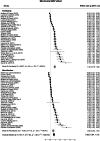A meta-analysis of event-related potential correlates of recognition memory
- PMID: 37434046
- PMCID: PMC10728276
- DOI: 10.3758/s13423-023-02309-y
A meta-analysis of event-related potential correlates of recognition memory
Abstract
A longstanding question in memory research is whether recognition is supported by more than one mnemonic process. Dual-process models distinguish recollection of episodic detail from familiarity, while single-process models explain recognition in terms of one process that varies in strength. Dual process models have drawn support from findings that recollection and familiarity elicit distinct electroencephalographic event-related potentials (ERPs): a mid-frontal ERP effect that occurs at around 300-500 ms post-stimulus onset and is often larger for familiarity than recollection contrasts, and a parietal ERP effect that occurs at around 500-800 ms and is larger for recollection than familiarity contrasts. We sought to adjudicate between dual- and single-process models by investigating whether the dissociation between these two ERP effects is reliable over studies. We extracted effect sizes from 41 experiments that had used Remember-Know, source memory, and associative memory paradigms (1,000 participants). Meta-analysis revealed a strong interaction between ERP effect and mnemonic process of the form predicted by dual-process models. Although neither ERP effect was significantly process-selective taken alone, a moderator analysis revealed a larger mid-frontal effect for familiarity than recollection contrasts in studies using the Remember-Know paradigm. Mega-analysis of raw data from six studies further showed significant process-selectivity for both mid-frontal and parietal ERPs in the predicted time windows. On balance, the findings favor dual- over single-process theories of recognition memory, but point to a need to promote sharing of raw data.
Keywords: Event-related potentials; Familiarity; Meta-analysis; Recognition memory; Recollection.
© 2023. The Author(s).
Figures







References
-
- Allan, K., Wilding, E. L., & Rugg, M. D. (1998). Electrophysiological evidence for dissociable processes contributing to recollection. Acta Psychologica, 98(2–3), 231–252. 10.1016/s0001-6918(97)00044-9 - PubMed
Publication types
MeSH terms
Grants and funding
LinkOut - more resources
Full Text Sources

